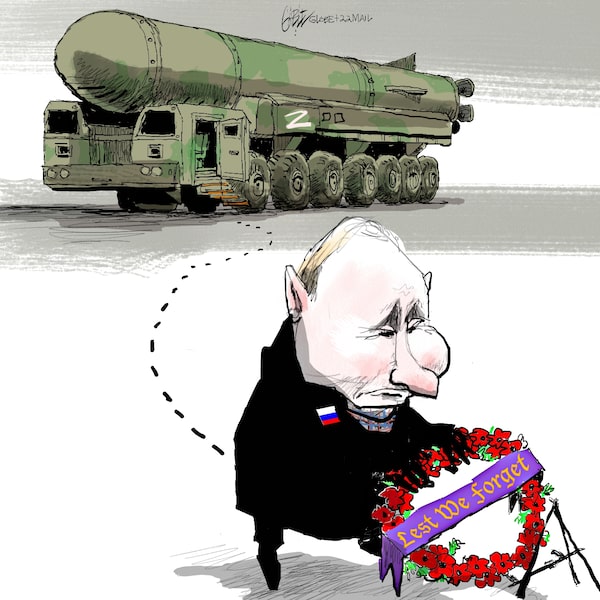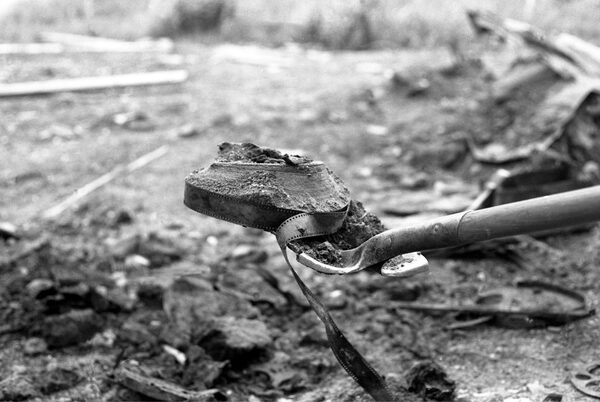Good morning,
Today, on Nov. 11, we are starting with our Remembrance Day coverage.
This RCAF photographer painted wartime Europe’s hardships and humanity. Now, a documentary is bringing his portraits to life
No one would dare suggest treating war like a cartoon. And yet, no one can deny that animation can be a powerful, engaging tool for reaching people of all ages. Such is the thinking of Toronto documentary maker Matthew Corolis. This Remembrance Day, he will be releasing the trailer for his nearly finished documentary, The Reconnaissance Painter, an animated short that tells the story of John Fleetwood-Morrow, who served as a photographer in No. 39 Wing RCAF.
Composed of airmen from three Canadian squadrons, 400, 414 and 430, this ‘recce’ wing became known as the Eyes of the Army. It would play a critical role in 1944′s Operation Overlord, the code name for the Battle of Normandy, which began on D-Day, June 6, 1944.

Watercolour painting of spitfires.John Fleetwood-Morrow/John Fleetwood-Morrow
This is the daily Morning Update newsletter. If you’re reading this on the web, or it was forwarded to you from someone else, you can sign up for Morning Update and more than 20 other Globe newsletters on our newsletter sign-up page.
Remembrance Day reminds of us of our obligation to do the hard work of democracy
Rory Gilfillan used to show pictures to his class of the Lakefield Old Boys – students at Lakefield College School (a private high school just north of Peterborough, Ont.) who had served in the wars of the 20th century. He would read aloud the letters they had sent home from the front. His intention was for his students to make a connection between themselves and these young men, to see that there was little separating them but the passage of time.
But recently, it dawned on him that in all the ways that matter, we are in fact nothing like these men. And it’s not just because our lives are easier, but because of something else altogether: very little has been asked of us.
It has been three generations since Canadians, en masse, have been called on to don a uniform, rack the bolt of a rifle, or strap ourselves behind the controls of a Lancaster bomber; to willingly put ourselves into harm’s way. While the Canadian Armed Forces continue to serve as the country’s defence, the vast majority of us who are alive today have never had to send waves of our sons, fathers and brothers to war with the knowledge that they might never return. Gilfillan imagines the men and women whom we commemorate on Remembrance Day might see our ignorance of war as a victory of sorts.

Rory Gilfillan is a history teacher and the head of social science at Lakefield College School.Supplied
Teenaged wartime evacuee Bridget Lawson became a Royal Canadian Navy decoder
The Second World War first altered the life of 15-year-old English schoolgirl Bridget Gregson (later known by her married name, Lawson) when she was evacuated from her boarding school in southern England and sent to Canada for safety along with her three younger siblings. Three years later, she graduated from high school and joined the Royal Canadian Navy to help in the war effort. She was sent to Halifax, where she worked as a decoder, and in May of 1945, she and a colleague saw the message sent to German U-boat crews to surface and surrender to the nearest Allied port.
She remained in Canada and died in Toronto on Oct. 29 at the age of 97.
Bridget Lawson, centre, who worked in Africa as a volunteer in later life, on a visit to AMREF in 2010.Courtesy of the Family
Got a news tip that you’d like us to look into? E-mail us at tips@globeandmail.com Need to share documents securely? Reach out via SecureDrop
Also on our radar
Justin Trudeau shot down the idea of negotiating government policy during convoy protests, referred to an ‘armed insurrection’: Prime Minister Justin Trudeau shot down the idea of negotiating changes to government policy and referred to an “armed insurrection” during discussions about convoy protests, according to notes tabled with the Emergencies Act inquiry on Thursday.
FTX collapse affecting investments by Canadian businesses, organizations: The collapse of FTX Ltd. is sending shock waves through the crypto industry, as the exchange scrambles to find a financial lifeline amid reports that it funnelled customer assets worth billions of dollars into risky bets through an affiliated trading firm.
Bill Blair and Alberta minister sparred over request for military assistance during Coutts blockade, text messages show: An Alberta cabinet minister complained to Minister of Emergency Preparedness Bill Blair that the province didn’t receive any help to clear a blockade at a border crossing until after the protest was already over and argued Ottawa was wrong to invoke the Emergencies Act, according to text messages at a federal inquiry.
Indigenous investors plan bids in TC Energy’s $5-billion asset sale: Indigenous investors are lining up to bid on Canadian pipelines TC Energy Corp. put up for auction this week as part of a $5-billion asset sale program.
Congo Basin, world’s second-biggest rainforest, now reported to be facing rapid destruction: Global efforts to protect Africa’s rainforests have failed to halt the rapid destruction of one of the world’s last intact tropical forests, a new study has found.
Morning markets
Relief rally continues: A relief rally in global shares entered a second day on Friday and the U.S. dollar dipped as investors bet that peaking U.S. inflation will prompt the Federal Reserve to ease the pace of interest rate hikes. Just before 6 a.m. ET, Germany’s DAX gained 0.35 per cent while France’s CAC 40 rose 0.53 per cent. Britain’s FTSE 100 slipped 0.31 per cent. In Asia, Japan’s Nikkei added 2.98 per cent. Hong Kong’s Hang Seng jumped 7.74 per cent. New York futures were positive. The Canadian dollar was higher at 75.11 US cents.
What everyone’s talking about
Increasing our population intake will not address the cynicism guiding Canada’s immigration policy
“Refugee rights activists all tell me the same thing: Canada is very good at playing the part of a caring global citizen, but in reality, its purported humanitarianism is self-interest in disguise.” – Adnan R. Khan
Despite FTX implosion, overzealous crypto enforcement is not the answer
“In Canada, regulatory attention has primarily focused on cryptocurrency trading platforms. Unfortunately, even regulation of this one segment of the blockchain industry has been distressed with uncertainty.” – Adam Chisholm
A tale of two convoys exposes Canada’s divisions
“While it may have been frustrating for the residents of Ottawa to see their tormenters platformed for a full week of testimony, an underlying lesson has emerged that has significant implications not just for the commission, but also for Canadian politics more broadly: There was not one, but two convoy realities.” – Stephanie Carvin
Today’s editorial cartoon

Brian Gable/The Globe and Mail
Living better
Heroic Hearts Project’s David Fascinato on his ayahuasca retreat and how psychedelics are helping veterans
Conversations about psychedelic drug use are no longer in the shadows, says David Fascinato, executive director of Heroic Hearts, who was approached two years ago to set up the Canadian offshoot of the U.S.-based Heroic Hearts Project, founded in 2017. Now, the executive director of the Heroic Hearts Project talks about his ayahuasca retreat and how psychedelics are helping Canadian veterans, including himself, heal.
Moment in time: Nov. 11, 1978
Hercules aircraft flies trove of silent films from Yukon to Ottawa

One of hundreds of old Hollywood movies is unearthed in a Dawson City excavation in 1978.Kathy Jones Gates/Dawson City: Frozen Time (2016) / Hypnotic Pictures / Picture Palace Pictures
Alderman Frank Barrett was overseeing the excavation at the site of a former hockey rink in Dawson City, Yukon, in July of 1978 when he struck gold: more than 1,100 reels of silent movies buried in the permafrost. Almost half had salvageable content – and most were the only surviving copies. The 372 film titles, produced between 1903 and 1929, included works starring legendary actors such as Lionel Barrymore and Douglas Fairbanks and even footage of the scandal-ridden 1919 World Series. Why were they there? During the Gold Rush, Dawson City had been the last stop on Hollywood’s distribution chain. Once movies screened in the Klondike, distributors didn’t want to pay for their return trip. Many were used to fill in the community swimming pool for an ice rink in 1929. The movies were shot on highly flammable nitrate film stock – one reason so many early films have been lost. Airlines refused to transport the dangerous goods. So, on Remembrance Day, 1978, the Canadian military flew the unearthed films from Whitehorse to Ottawa to be preserved at the national archive – resurrecting the missing performances of cinema’s pioneers. Joy Yokoyama.
Read today's horoscopes. Enjoy today's puzzles.
If you’d like to receive this newsletter by e-mail every weekday morning, go here to sign up. If you have any feedback, send us a note.